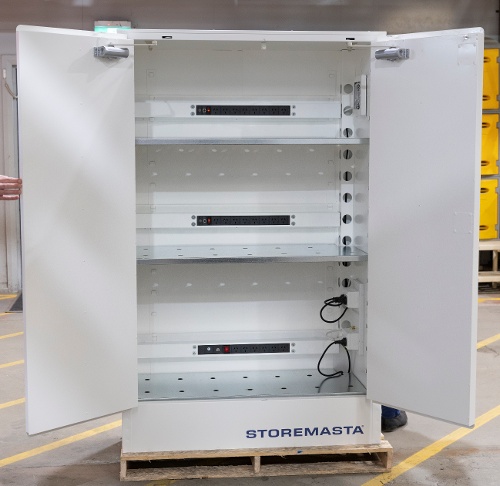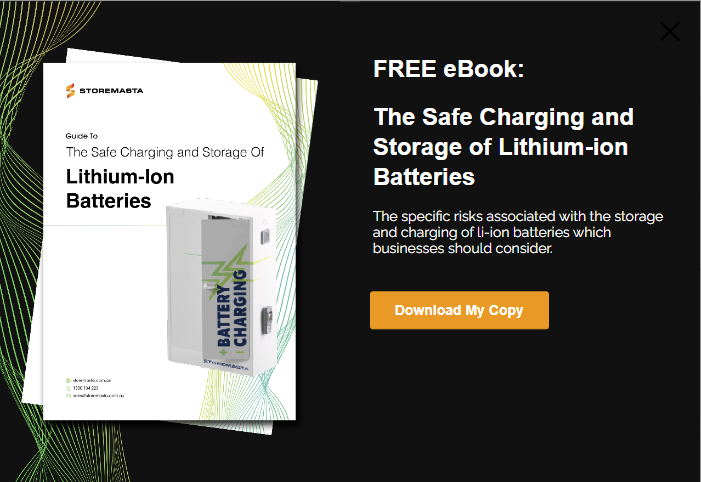Whether you’re operating drones, mobile phones, forklifts, industrial robots or solar panels, your business will rely on lithium-ion batteries. With the increasing popularity of this type of battery technology, there also comes an increased awareness of the risks that these batteries pose to the workplaces that use them. You have probably seen recent news reports about faulty or overheated batteries causing devastating destruction to Australian homes and businesses. Thankfully, lithium-ion battery fires and explosions aren’t everyday occurrences, but these dangerous incidences can happen when batteries aren’t maintained, charged and stored in a safe, sensible way. In this post, we’ll be outlining some key considerations for lithium-ion battery storage which will actively reduce the likelihood and impact of fire, explosion and thermal runaway.
How Can Storage Reduce Lithium Batteries Risk?
When charging and storing lithium batteries, there are a variety of risks that require controls to sustain a safe working environment.
Li-ion batteries must be protected against:
- Overheating
- Overcharging
- Impact damage
- Water exposure
- Humidity
- Poor charging practices
Lithium-ion batteries should never be treated as a simple office or workplace item. These batteries are recognised as Class 9 Miscellaneous Dangerous Goods, and must be used, charged and stored as per the manufacturer’s instructions.

To reduce hazards with your rechargable batteries, make sure that you follow the manufacturer’s instructions for handling, charging and storage.
Failure to do so can lead to the battery becoming unstable; potentially swelling up, melting, leaking — or causing a fire or explosion.
How Can Battery Storage Reduce Risk?
Battery storage for lithium-ion batteries is becoming a hot topic in the business world.
Whether you’re running a large manufacturing company or you’re in a small home office, anyone who carries any type or quantity of Li-on batteries must be aware of the operational and storage instructions for their products.
Concerned about battery safety?
Find out more with our free eBook
If your batteries are not maintained and stored in the correct manner, your Li-ion batteries can become volatile. Therefore, battery storage and charging cabinets are the safest storage option.
Battery cabinets are specifically designed to protect the cells within the store from excessive heat, fire, misuse and impact damage. They provide a secure space where charging can be carried out with minimum risk.
Battery cabinets are designed to have:
- A heat and fire barrier to help prevent batteries igniting
- Liquid-tight unit to catch hydrofluoric acid leaks
- Secure storage prohibiting unauthorised entry
- Protection against impact damage
- Non-combustible surfaces for battery charging
- Cool, dry environment for safe battery storage
Due to the chemistry of lithium-ion batteries — and their sensitivity to heat, humidity and stress — it’s important to understand the optimum conditions in which this type of battery should be stored.
How to Store Lithium-ion Batteries When Not in Use
While there is an increase in risk during charging, lithium batteries can still ignite when they aren't being used. Some factors that could increase the risk include exposure to water, heat or impact damage.
Whether you're using your batteries or not, it's best practice to store these batteries in a dedicated battery cabinet that can reduce the likelihood and impact of battery fires. Staff should NEVER leave batteries lying around a workplace, in direct sunlight, in busy areas where they could be knocked or damaged or in vehicles where they can overheat and cause a fire risk.
Choose battery storage for all batteries, regardless of whether they are required for use, in long-term storage or being charged.
Key Considerations for Your Cabinet
When determining your dangerous goods storage needs, particularly with Class 9 lithium-ion batteries, it’s important that your storage equipment is purchased after a thorough risk assessment. Workplaces can have numerous chemical hazards present in the one work area, with storage dependent on the risk levels of these hazards.
We always recommend speaking with a Dangerous Goods Specialist or Consultant before installing any type of safety cabinet in your organisation. This is to ensure that you fully understand the risks at your site, and that your equipment is the right choice for your business.
Here are the key considerations for lithium-ion battery storage that can help you reduce hazards in your organisation:
Heat and Fire Protection
Does your store offer heat and fire protection for your battery cells? In the event of a workplace fire, your batteries (and any dangerous goods) could potentially ignite — adding to the severity and toxicity of the fire.
Battery charging and storage cabinets should be constructed with sheet steel and feature a thermic air barrier between the walls. The construction provides a protective layer against heat and fire, that allows staff a small window of time to evacuate the building and notify firefighting services.
The construction of the cabinet, in turn, will help to contain a fire if it happens to break out while the batteries are charging within the closed cabinet.
Li-ion battery fires can cause rapid and devastating destruction to businesses and the community that surrounds them. Not only are they fierce, fast-burning blazes, they also are very difficult to put out due to the cells reigniting after they have been extinguished.
When businesses carry multiple Li-ion cells, there is an increased risk of thermal runaway occurring in the stores – with multiple batteries causing fire or explosion, due to their exposure to heat and fire.
Heat and fire protection provides an essential risk control measure for battery stores, by reducing the impact of a catastrophic blaze.
Leak Containment
While lithium-ion batteries aren’t prone to leaking like alkaline or lead-acid batteries, they can still leak flammable electrolyte if the battery cell is damaged. If this liquid comes into contact with water, it can become hydrofluoric acid.
Battery storage cabinets provide a liquid-tight leak containment sump that allows staff to contain leaks, so they can dispose of the waste in a compliant manner. If leaks from your batteries do occur, the correct PPE should be used, with the battery and waste discarded as per the requirements of your local government body.
Lithium Battery Storage
Preventing unauthorised entry to your stores of Li-ion batteries is an essential part of ensuring your batteries remain in excellent working order. Battery storage cabinets should be equipped with lockable doors that prevent the misuse, theft or vandalism of your lithium-ion batteries.
By providing a dedicated and secure storage space for your batteries, you’re also encouraging staff to be diligent with their charging and storage duties. Lithium-ion batteries should never be left lying around, as they may be adversely impacted by the ambient temperature of a room, which may lead to overheating of the cell.

Beware of swollen lithium-ion batteries as these can present a fire risk.
Special care must always be taken to ensure that damaged, swollen or aged batteries aren’t put on charge. Faulty or old batteries can spark a battery fire if they aren’t noted by staff — and disposed of safely.
REMEMBER: Lithium-ion batteries should be monitored to avoid overcharging of the cell. Never leave your batteries charging overnight unattended, and always inspect your batteries before you plug them in to the charger.
Sheet Steel Construction
Did you know that lithium-ion batteries should never be charged near flammable or combustible materials? This may include a wooden work bench, a couch in your office, or even a seat in your vehicle.
Heat can be generated when lithium-ion batteries are on charge. Therefore, placing them on a soft or combustible surface can increase the risk of the battery overheating and igniting.
An ideal surface for charging batteries is a sheet steel shelf. Steel is a durable material that is perfect for battery cabinet construction, as it minimises the risk of batteries overheating and combusting.
The sheet steel design of the battery cabinet (equipped with a thermic air barrier within the walls) also assists with maintaining a temperature-controlled environment for battery charging and storage.
The durability of the steel cabinet also helps prevent incidents of impact damage, which may adversely affect the safety of the battery cells.
Cooling System
Providing a cool, dry environment for battery charging and storage is one of the most important considerations for Li-ion cells in the workplace.
The ambient temperature of your storage area will have a direct effect on the temperature of your battery cells. Excessive heat and humidity can decrease the performance of your battery, as well as increase the likelihood of the battery overheating or succumbing to thermal runaway.
It’s crucial that lithium-ion batteries are stored in a cool, dry environment to maintain the performance of the battery — as well as its safety.
Therefore, we recommend storing batteries in an inside environment, that is away from direct sunlight, excess heat, ignition sources and flammable substances.
IMPORTANT: Our battery cabinets are equipped with 150mm fans which push 67 m3 of air through the cabinet every hour. This assists with the dispersion of hot air and humidity, decreasing the risk of cells overheating. Cabinets also have the provision for mechanical ventilation systems if this is deemed necessary by your risk assessment.
Compliant Electrical Work
Another key consideration when selecting battery storage for your business is the compliance of the electrical work. Faulty electrical work can result in sparks or unstable currents which may affect your batteries while they’re on charge.
Battery cabinets must be electrically safe to reduce risk with your Li-ion stores.
Look for a battery cabinet that’s been checked by a licensed electrician whose electrical work meets the requirements of the Australian Standards.
You should also ensure that your battery chargers are suitable for your products, as cheaper models may increase risk during the battery charging process.
REMEMBER: Aged, damaged and faulty batteries can ignite when put on charge. Always check your lithium-ion stores to ensure your batteries are in excellent condition — prior to going on charge.
Lithium Battery Storage for all Businesses
While the risks associated with lithium-ion batteries are getting more and more press these days, there are engineering controls that you can implement to minimise the likelihood and impact of battery fires, explosion and thermal runaway. Storing batteries in a secure, cool and dry environment — that’s free from impact damage, misuse and theft — can assist in maintaining a safer workplace for businesses who use Li-ion cells.
Are you interested in learning more about lithium-ion batteries and how to control the risks? OurGuide to the Safe Charging and Storage of Li-ion Batteries will highlight key considerations for your workplace in your battery handling and storage areas. We'll also introduce you to our 4-step risk management methodology that can be applied to any workplace across any industry. Grab your free copy today and create a safer working environment with lithium-ion batteries.

Living life by the 4 C’s of marketing – communication, coffee, compliance… and more coffee – Leisa Andersen is Storemasta’s Content Marketing Manager. When she’s not writing, you’ll find her enjoying all the good things in life, including shopping, travel and gluten free donuts.

